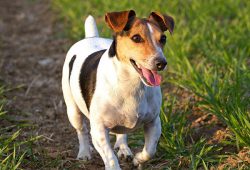The Jack Russell Terrier is a small terrier that has its origins in fox hunting. It is principally white-bodied and smooth, rough or broken-coated but can be any colour.
The Jack Russell is frequently confused with the Parson Russell terrier and the Russell terrier, which is a shorter-legged, stockier variety. (Within the Fédération Cynologique Internationale, the “Russell terrier” is also known as “Jack Russell terrier”.) The term “Jack Russell” is also commonly misapplied to other small white terriers. The Jack Russell is a broad type, with a size range of 10–15 inches (25–38 cm). The Parson Russell is limited only to a middle range with a standard size of 12–14 inches (30–36 cm), while the Russell terrier is smaller at 8–12 inches (20–30 cm). Each breed has different physical proportions according to the standards of their breed clubs.
Description
Due to their working nature, Jack Russell terriers remain much as they were some 200 years ago. They are sturdy, tough, and tenacious, measuring between 10–15 inches (25–38 cm) at the withers, and weigh 14–18 pounds (6.4–8.2 kg). The body length must be in proportion to the height, and the dog should present a compact, balanced image. Predominantly white in coloration (more than 51%) with black and/or brown and/or tan markings, they exhibit either a smooth, rough or a combination of both which is known as a broken coat. A broken-coated dog may have longer hair on the tail or face than that which is seen on a smooth-coated dog. The skin can sometimes show a pattern of small black or brown spots, referred to as “ticking” that do not carry through to the outer coat. All coat types should be dense double coats that are neither silky (in the case of smooth coats) nor woolly (in the case of rough coats).
The head should be of moderate width at the ears, narrowing to the eyes, and slightly flat between the ears. There should be a defined but not overpronounced stop at the end of the muzzle where it meets the head, and a black nose. The jaw should be powerful and well boned with a scissor bite and straight teeth. The eyes are almond shaped and dark coloured and should be full of life and intelligence. Small V-shaped ears of moderate thickness are carried forward on the head. When the dog is alert, the tip of the V should not extend past the outer corner of the eyes. The tail is set high and in the past was docked to approximately five inches in order to provide a sufficient hand-hold for gripping the terrier.
Temperament
Jack Russells are first and foremost a working terrier. Originally bred to bolt foxes from their dens during hunts, they are used on numerous ground-dwelling quarry such as groundhog, badger, and red and grey fox. The working JRT is required to locate quarry in the earth, and then either bolt it or hold it in place until they are dug to. To accomplish this, the dog will not bark but will expect attention to the quarry continuously. Because the preservation of this working ability is of highest importance to most registered JRTCA/JRTCGB breeders, Jack Russells tend to be extremely intelligent, athletic, fearless, and vocal dogs. It is not uncommon for these dogs to become moody or destructive if not properly stimulated and exercised, as they have a tendency to bore easily and will often create their own fun when left alone to entertain themselves.
Their high energy and drive make these dogs ideally suited to a number of different dog sports such as flyball or agility. Obedience classes are also recommended to potential owners, as Jack Russells can be stubborn at times and aggressive towards other animals and humans if not properly socialized. Despite their small size, these dogs are not recommended for the condominium or apartment dweller unless the owner is ready to take on the daunting task of providing the dog with the necessary amount of exercise and stimulation. They have a tremendous amount of energy for their size, a fact which can sometimes lead to trouble involving larger animals. They may seem never to tire and will still be energetic after their owner has called it a day. While socialised members of the breed are friendly towards children, they will not tolerate abuse even if it is unintentional.
Health
The breed has a reputation for being healthy with a long lifespan. Breeders have protected the gene pool, and direct in-line breeding has been prevented. Jack Russells can live from 13 to 16 years given proper care. However, certain lines have been noted for having specific health concerns and, therefore, could occur in any line or generation because of recessive genes. These issues can include hereditary cataracts, ectopia lentis, congenital deafness, patellar luxation, ataxia, myasthenia gravis, Legg–Calvé–Perthes syndrome, and von Willebrand disease.
Being a hunt-driven dog, the Jack Russell will usually pursue most creatures that it encounters. This includes the skunk, and the breed is prone to skunk toxic shock syndrome. The chemical in the skunk spray is absorbed by the dog and causes the red blood cells to undergo haemolysis, which can occasionally lead to fatal anaemia and kidney failure. If sprayed underground, it can also cause chemical burning of the cornea. Treatments are available to flush the toxin out of the dog’s system.
Jack Russell Terrier. (2017, June 18). In Wikipedia, The Free Encyclopedia. Retrieved from https://en.wikipedia.org/w/index.php?title=Jack_Russell_Terrier&oldid=786304811


